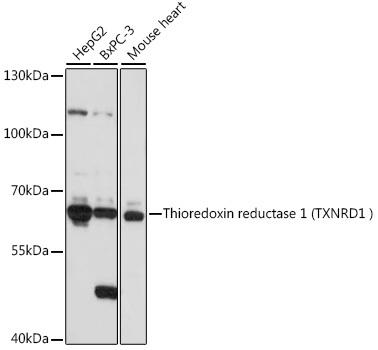TrxR1 antibody
GTX110589
ApplicationsWestern Blot, ImmunoHistoChemistry, ImmunoHistoChemistry Paraffin
Product group Antibodies
TargetTXNRD1
Overview
- SupplierGeneTex
- Product NameTrxR1 antibody
- Delivery Days Customer9
- Application Supplier NoteWB: 1:500-1:3000. IHC-P: 1:100-1:1000. *Optimal dilutions/concentrations should be determined by the researcher.Not tested in other applications.
- ApplicationsWestern Blot, ImmunoHistoChemistry, ImmunoHistoChemistry Paraffin
- CertificationResearch Use Only
- ClonalityPolyclonal
- Concentration0.5 mg/ml
- ConjugateUnconjugated
- Gene ID7296
- Target nameTXNRD1
- Target descriptionthioredoxin reductase 1
- Target synonymsGRIM-12, TR, TR1, TRXR1, TXNR, TXNR1, thioredoxin reductase 1, cytoplasmic, KM-102-derived reductase-like factor, gene associated with retinoic and IFN-induced mortality 12 protein, gene associated with retinoic and interferon-induced mortality 12 protein, oxidoreductase, peroxidase TXNRD1, selenoprotein TXNRD1, testis tissue sperm-binding protein Li 46a, thioredoxin reductase GRIM-12, thioredoxin reductase TR1
- HostRabbit
- IsotypeIgG
- Protein IDQ16881
- Protein NameThioredoxin reductase 1, cytoplasmic
- Scientific DescriptionThis gene encodes a member of the family of pyridine nucleotide oxidoreductases. This protein reduces thioredoxins as well as other substrates, and plays a role in selenium metabolism and protection against oxidative stress. The functional enzyme is thought to be a homodimer which uses FAD as a cofactor. Each subunit contains a selenocysteine (Sec) residue which is required for catalytic activity. The selenocysteine is encoded by the UGA codon that normally signals translation termination. The 3 UTR of selenocysteine-containing genes have a common stem-loop structure, the sec insertion sequence (SECIS), that is necessary for the recognition of UGA as a Sec codon rather than as a stop signal. Alternative splicing results in several transcript variants encoding the same or different isoforms. [provided by RefSeq]
- Storage Instruction-20°C or -80°C,2°C to 8°C
- UNSPSC12352203
References
- Arodin Selenius L, Wallenberg Lundgren M, Jawad R, et al. The Cell Culture Medium Affects Growth, Phenotype Expression and the Response to Selenium Cytotoxicity in A549 and HepG2 Cells. Antioxidants (Basel). 2019,8(5). doi: 10.3390/antiox8050130Read this paper
- Misra S, Selvam AK, Wallenberg M, et al. Selenite promotes all-trans retinoic acid-induced maturation of acute promyelocytic leukemia cells. Oncotarget. 2016,7(46):74686-74700. doi: 10.18632/oncotarget.12531Read this paper






